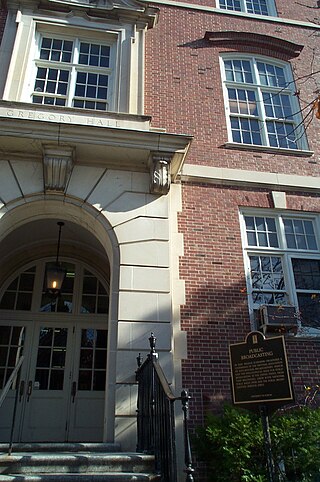
The Corporation for Public Broadcasting (CPB) is an American publicly funded non-profit corporation, created in 1967 to promote and help support public broadcasting. The corporation's mission is to ensure universal access to non-commercial, high-quality content and telecommunications services. It does so by distributing more than 70 percent of its funding to more than 1,400 locally owned public radio and television stations.
Public broadcasting involves radio, television and other electronic media outlets whose primary mission is public service. Public broadcasters receive funding from diverse sources including license fees, individual contributions, public financing and commercial financing, and avoid political interference or commercial influence.

National Educational Television (NET) was an American educational broadcast television network owned by the Ford Foundation and later co-owned by the Corporation for Public Broadcasting. It operated from May 16, 1954, to October 4, 1970, and was succeeded by the Public Broadcasting Service (PBS), which has memberships with many television stations that were formerly part of NET.
WNET, branded on-air as "Thirteen", is a primary PBS member television station licensed to Newark, New Jersey, United States, serving the New York City area. Owned by The WNET Group, it is a sister station to the area's secondary PBS member, Garden City, New York–licensed WLIW, and two class A stations which share spectrum with WNET: WNDT-CD and WMBQ-CD ; through an outsourcing agreement, The WNET Group also operates New Jersey's PBS state network NJ PBS and the website NJ Spotlight.

The New Jersey Network (NJN) was a network of public television and radio stations serving the U.S. state of New Jersey. NJN was a member of the Public Broadcasting Service (PBS) for television and the National Public Radio (NPR) for radio, broadcasting their programming as well as producing and broadcasting their own programming, mostly relating to issues in New Jersey. With studios in both Trenton and Newark, NJN's television network covered all of New Jersey, plus parts of Pennsylvania, New York, Connecticut and Delaware. The radio network primarily served several areas of New Jersey that were not covered by Philadelphia and New York City public radio stations.
WLIW is a secondary PBS member television station licensed to Garden City, New York, United States, serving the New York City television market. It is owned by The WNET Group alongside the area's primary PBS member, Newark, New Jersey–licensed WNET ; two Class A stations which share spectrum with WNET, WNDT-CD and WMBQ-CD ; and WLIW-FM (88.3) in Southampton. Through an outsourcing agreement, The WNET Group also operates New Jersey's PBS state network NJ PBS and the website NJ Spotlight.
The Oklahoma Educational Television Authority (OETA) is a state network of PBS member television stations serving the U.S. state of Oklahoma. The authority operates as a statutory corporation that holds the licenses for all of the PBS stations operating in the state; it is managed by an independent board of gubernatorial appointees, and university and education officials, which is linked to the executive branch of the Oklahoma state government through the Secretary of Education.

The Public Broadcasting Act of 1967 issued the congressional corporate charter for the Corporation for Public Broadcasting (CPB), a private nonprofit corporation funded by taxpayers to disburse grants to public broadcasters in the United States, and eventually established the Public Broadcasting Service (PBS) and National Public Radio (NPR). The act was supported by many prominent Americans, including Fred Rogers, NPR founder and creator of All Things Considered Robert Conley, and Senator John O. Pastore of Rhode Island, then chairman of the Senate Subcommittee on Communications, during House and United States Senate hearings in 1967.
WFWA is a PBS member television station in Fort Wayne, Indiana, United States. Owned by Fort Wayne Public Television, Inc., the station maintains studios at the Dr. Rudy and Rhonda Kachmann Teleplex on the campus of Purdue University Fort Wayne, and its transmitter is located at its former studio facility on Butler Road in Fort Wayne.

KUT is a listener and community supported public radio station based in Austin, Texas. KUT is owned and operated by the University of Texas at Austin. It is the National Public Radio member station for central Texas. Its studio operations are located on campus at the Dealey Center for New Mediahttps://news.utexas.edu/2021/06/10/uts-belo-center-for-new-media-renamed-the-g-b-dealey-center-for-new-media/]. KUT is one of three radio outlets based on UT campus alongside student-run KVRX 91.7 FM and KUTX 98.9 FM.

An underwriting spot, known as sponsor credit in Japan, is an announcement made on public broadcasting outlets, especially in the United States, in exchange for funding. These spots usually mention the name of the sponsor, and can resemble traditional television advertisements in commercial broadcasting to a limited extent; however, under the terms of a public broadcaster's license from the Federal Communications Commission, such spots are prohibited from being promotional or making any sort of "call to action". In the U.S., these restrictions apply to any television or radio station licensed as a non-commercial educational (NCE) stations, and even for non-sponsoring companies and products. However, this is not the case in Japan, as these spots can be played on both public and private broadcasters and are typically played alongside traditional commercials and appear after a show's opening theme or after a preview of a next episode or appear during a scene of a show.
Create is an American digital broadcast public television network broadcast on digital subchannels of PBS member stations. The network broadcasts how-to, DIY and other lifestyle-oriented instructional programming 24 hours a day.
A sustaining program is a radio or television program that, despite airing on a commercial broadcast station, does not have commercial sponsorship or advertising. This term, mostly used in the United States, was common in the early days of radio, but has become unfamiliar owing to the nearly universal use of commercial advertising on radio and television.

World Channel, also branded as World, is an American digital multicast public television network owned and operated by the WGBH Educational Foundation. It is distributed by American Public Television and the National Educational Telecommunications Association and features programming covering topics such as science, nature, news, and public affairs. Programming is supplied by the entities, as well as other partners such as WNET and WGBH. It is primarily carried on the digital subchannels of PBS member stations.

National Public Radio is an American non-profit media organization headquartered in Washington, D.C., with its NPR West headquarters in Culver City, California. It serves as a national syndicator to a network of over 1,000 public radio stations in the United States. It differs from other non-profit membership media organizations, such as the Associated Press, in that it was established by an act of Congress.

The Public Broadcasting Service (PBS) is an American public broadcaster and non-commercial, free-to-air television network based in Arlington, Virginia. PBS is a publicly funded nonprofit organization and the most prominent provider of educational programs to public television stations in the United States, distributing shows such as Frontline, Nova, PBS NewsHour, Arthur, Sesame Street, and This Old House.
Florida Public Broadcasting Service (FPBS) is a non-profit organization representing Florida's PBS television and NPR radio stations. FPBS works with PBS and NPR member stations, along with state and local groups, to deliver education based outreach projects and provide high quality programming." FPBS has a total of 14 member stations that covers 99% of Florida viewers, as well as some viewers in Georgia and Alabama.

In the United States, other than a few direct services, public broadcasting is almost entirely decentralized and is not operated by the government, but does receive some government support.
Vermont Public Co. is the public broadcaster serving the U.S. state of Vermont. Its headquarters, newsroom, and radio studios are located in Colchester, with television studios in Winooski. It operates two statewide radio services aligned with NPR, offering news and classical music, and the state's PBS service. It was formed by the 2021 merger of what had been previously separate organizations, Vermont Public Radio and Vermont Public Television, which were both renamed Vermont Public in 2022.









